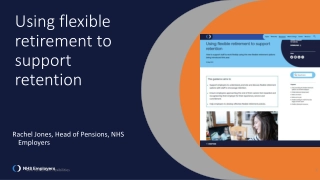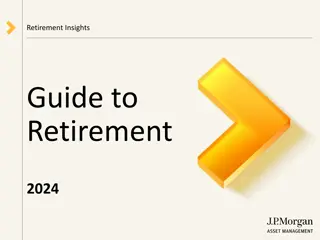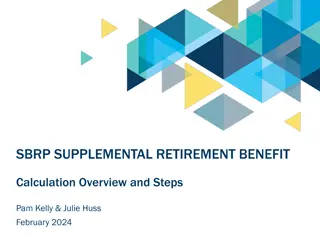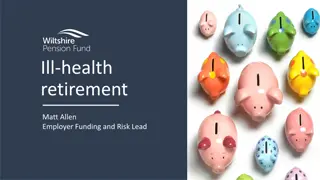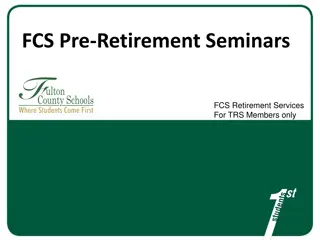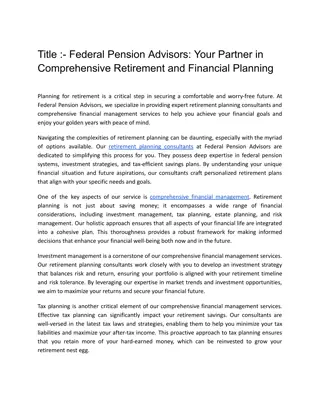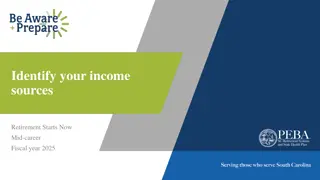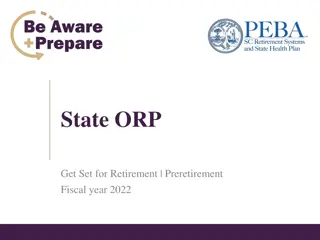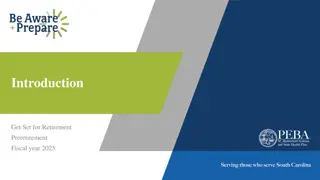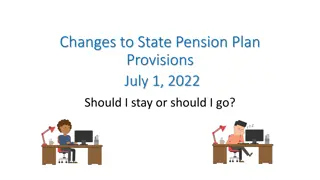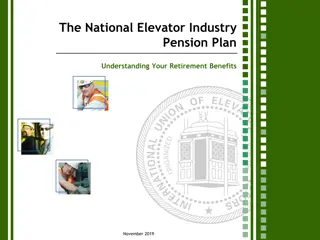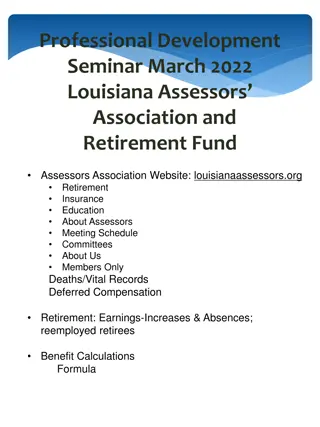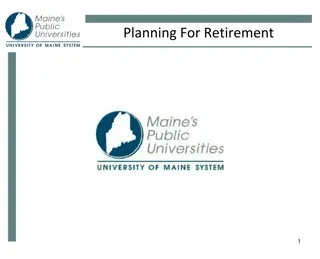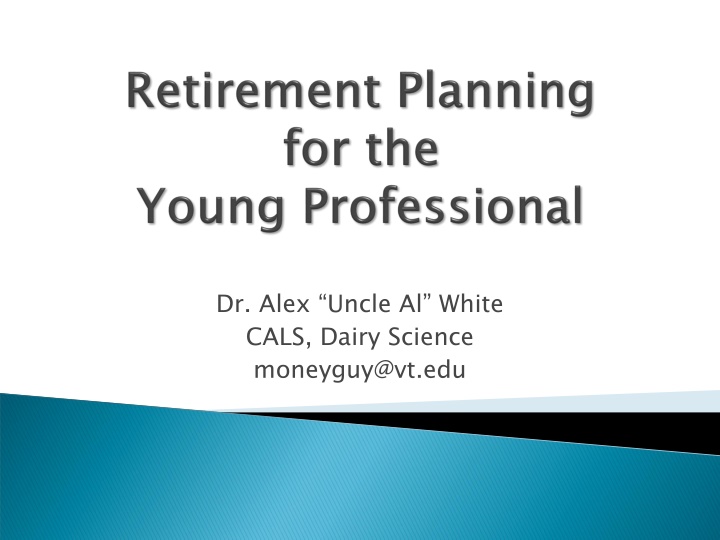
Retirement Planning Overview and Social Security Benefits Considerations
"Explore key aspects of retirement planning, including tax benefits, investment options, and funding strategies. Understand the potential impact of Social Security benefits on your retirement income. Learn about saving options such as VT plans, IRAs, and other assets to achieve your financial goals."
Download Presentation

Please find below an Image/Link to download the presentation.
The content on the website is provided AS IS for your information and personal use only. It may not be sold, licensed, or shared on other websites without obtaining consent from the author. If you encounter any issues during the download, it is possible that the publisher has removed the file from their server.
You are allowed to download the files provided on this website for personal or commercial use, subject to the condition that they are used lawfully. All files are the property of their respective owners.
The content on the website is provided AS IS for your information and personal use only. It may not be sold, licensed, or shared on other websites without obtaining consent from the author.
E N D
Presentation Transcript
Dr. Alex Uncle Al White CALS, Dairy Science moneyguy@vt.edu
Retirement planning overview Tax benefits of qualified retirement accounts Basic retirement planning calculations Types of VT plans Retirement plans for other income Understanding your investment options Questions
Social Security Maximum benefit < ~$45,000/year Will it be there at all for you? Social Security ~ 40% of pre-retirement income Inflation $50,000/yr today = $160,000/ $160,000/yr yr in 40 years in 40 years (3%) Funding your retirement lifestyle 45-yr old, $50k eq. for 30 years = ~$1.5 million 4% real rate of return, BOP 20-yr old, $50k eq, for 30 years = ~$3.4 million ~$3.4 million
These numbers assume that you have NO other sources of income during retirement NO With VRS benefits, it s a lot prettier sight! With other retirement savings, it s prettier IRAs, 403(b), 457, etc. With other assets, it s even prettier Rental properties, annuities, equity, financial assets, etc.
Goal: $3 million in 40 years Or $160,000/year equivalent Assumptions: Starting salary Annual increase in salary Average annual earnings ORP (plan 2) grows to $2.0 million VRS (plan 2) provides $85,000/year Roughly $1.5 million $60,000 2% 7% APY ORP (plan 2) grows to $2.0 million VRS (plan 2) provides $85,000/year
VRS Hybrid 4% DB+ 5% DC contribution = ~$2.0 million eq. ~$2.0 million eq. In addition: 403(b) & state matching funds 5% of salary into 403(b) + match = $860,000 10% = $1.6 million In addition: $860,000 $1.6 million IRAs, other retirement, etc.
Determining: When you want to retire What you want to do in your retirement years Your retirement lifestyle What will it cost? How you will fund that lifestyle VT, non-VT retirement plans, IRAs Social Security (yeah, riiiiight ) Personal savings, investments Continued work Rental or sale of property
Age 59 is minimum age for most retirement plans* Social Security: Normal Retirement Age: 65+ (67 for most of you) Earliest Retirement Age: 62 Medicare: Age 65*
Main Expense Categories: Housing - Rent/Mortgage, utilities, repairs Food Medical Insurances health, life, house, car, LTC Taxes property, income, etc. Travel & transportation Entertainment Gifts, charity, grandkids Clothing Other
What will you do differently? Housing, food, entertainment, etc. Typical pattern: Expenses increase dramatically for the first 2-4 years Then they settle into a normal pattern Then they increase dramatically due to medical exp.
Email me for my basic Excel spreadsheet axwhite@vt.edu Still working on a VT-specific one Or use sites like: http://www.bankrate.com/calculators/retirement/r etirement-plan-calculator.aspx http://money.cnn.com/calculator/retirement/retire ment-need/
Your contributions are pre-tax Lowers your taxable income Employer contributions are not included in your taxable income Taxed when withdrawn from the account
Earnings are tax deferred Taxed as ordinary income at withdrawal Roth accounts: After-tax contributions Tax-free earnings (5 yrs, age 59 ) Roth accounts:
No capital gains treatment All earnings are treated as ordinary income Early withdrawal penalty Before age 59 * 10% penalty on the withdrawal* + income taxes * Roth accounts are different VRS significant reduction in benefits Roth accounts are different
Dollar Cost Averaging Investing the same dollar amount into your account each period Painless & Brainless! Automatic deposit or payroll deduction (403(b)/457) You don t have to think about how many shares to buy Example: Invest $50/pay period into your 403(b) When the stock market is high, $50 buys less shares When the market is low, $50 buys more shares The shares are on sale !
VRS Virginia Retirement System Plan 1 hired pre-June 2010, vested by Jan 2013 Plan 2 hired post-June 2010, not vested by Jan 2013 Defined Benefit Annual Benefit = years x average salary** x 1.7% Your contribution = 5% of salary Defined Benefit plan
VRS Hybrid Plan Defined Benefit You contribute 4% of your salary Benefit based on ending salary & years of service x 1% Ending salary is average of 60 months consecutive Defined Contribution You contribute 1% of your salary Can contribute up to 5% (0.5% increments) VT matches $1-for-$1 on the first 1% $0.50-for-$1 after that You choose how to invest these funds Defined Benefit portion (similar to VRS 1 & 2) Defined Contribution portion (similar to ORP)
ORP Optional Retirement Plan Plan 1 = 10.4% of your salary from employer Plan 2 = 8.5% of your salary from VT + 5% from employee Defined Builds a pot of money, not an annual benefit Through TIAA-CREF or Fidelity Defined Contribution Contribution plan
403(b) Can contribute up to $18,000/year pre-tax $6,000 catch-up provision if over age 50 Reduces income taxes, grows tax deferred Qualifies you for cash match Through TIAA-CREF and/or Fidelity 457 Similar to 403(b) Most VT employees can double dip Allows in-service distributions after age 55 Through ICMA-RC - 403(b) Salary Reduction Salary Reduction Plan Plan 457 Salary Reduction Salary Reduction Plan Plan formerly through ING
401(a) Cash Match VA will match 50% of your 403(b) or 457 contribution Up to $20/pay period Not included in your taxable income Through TIAA-CREF, Fidelity and/or ICMA-RC To me, the 403(b) or 457 and the 401(a) are no To me, the 403(b) or 457 and the 401(a) are no- -brainers!! brainers!!
VRS 1 & 2 nothing for you to do ORP, 403(b), 457, 401(a), & VT Hybrid You need to determine how to invest your funds Match your investments to your: Goals, date of retirement, and risk tolerance It s not a once and done decision Review and revise your investments regularly Regularly = every year or so
Traditional IRAs Contributions up to $5,500/yr ($1,000 catch-up) May be tax deductible If AGI < $61,000-$71,000 (single) If AGI < $98,000-$118,000 (married/joint)
Roth IRAs Same contribution limits as traditional After-tax contributions Tax-free withdrawals (5 yrs, age 59 ) Single AGI < $117,000-$132,000 Married/Joint AGI < $184,000-$194,000
SIMPLE-IRA a small business 401(k) Contributions up to $12,500/yr ($15,500) SEP-IRA a small business pension Contributions up to ~25% of earnings Maximum of $53,000/yr (no catch-up provision) Individual/Solo 401(k) Similar to SEP-IRA contributions Annuities provide tax-deferred growth
Use the investment options provided TIAA, Fidelity, or ICMA-RC Spread your funds among: Equities (stocks) and fixed income (bonds) Large, mid-size and small firms Value and growth funds US and international
Rough starting point Your Age = % of funds in safe investments (fixed) 100 Your Age = % in riskier investments (equities) Then, adjust to match your risk tolerance & goals For VRS Hybrid or VRS plans 1 or 2 Treat your benefit as fixed You can probably take more risk with your funds Maybe 120 Age depends on your situation
Set your target percentages for your funds Ex. 45% US stocks, 45% US bonds, 10% international Some funds will outperform others, thereby throwing off your percentages 65% US stocks, 30% US bonds, 5% international This is more risky than you may want! Move funds from the winners to the losers to maintain your percentages Buy the underperformers while they re on sale
As you age, you typically want to reduce the riskiness of your portfolio Less risky assets, more safer assets Remember the 100 Your Age guideline Every few years, adjust your percentages If you don t, your account will be much riskier than you think! Big Question - Do you have the time, desire and knowledge to do this?
Al 25 years old, new employee Invests $1,200/yr: 80% in stocks, 20% in fixed Assumed annual returns Stocks 10% Fixed (Bonds) 5% With no rebalancing or reallocation, at age 65 Al s portfolio is: 94% stocks, 6% fixed - very risky!! How s that for un-noticed risk exposure!
Al 25 years old, new employee Invests $1,200/yr: 50% in stocks, 50% in fixed Assumed average annual returns Stocks 10% Fixed (Bonds) 5% With no rebalancing or reallocation, at age 65 Al s portfolio is: 80% stocks, 20% fixed = a lot of risk exposure Note to self: Rebalance & Reallocate regularly
As retirement date approaches, they become more conservative If you are more risk averse, choose a fund with a date closer than your expected retirement date If you are less risk averse, choose a fund with a date after your expected retirement date Passively managed (relatively) Do they adjust for changes in the economy?
Determine your retirement living needs & goals Build in your desired lifestyle Determine how much you need to invest to reach your goals Allocate your funds (100 - Your Age) Keep an eye on your accounts Rebalance periodically Reallocate every few years Don t hesitate to get help if/when you need it!
Dr. Alex White Dairy Science Virginia Tech moneyguy@vt.edu I am not a licensed investment advisor. I merely teach the basics.

